Solar eclipse of May 20, 2012
| Solar eclipse of May 20, 2012 | |
|---|---|
|
From Middlegate, Nevada | |
 Map | |
| Type of eclipse | |
| Nature | Annular |
| Gamma | 0.4828 |
| Magnitude | 0.9439 |
| Maximum eclipse | |
| Duration | 346 sec (5 m 46 s) |
| Coordinates | 49°06′N 176°18′E / 49.1°N 176.3°E |
| Max. width of band | 237 km (147 mi) |
| Times (UTC) | |
| (P1) Partial begin | 20:56:07 |
| (U1) Total begin | 22:06:17 |
| Greatest eclipse | 23:53:54 |
| (U4) Total end | 1:39:11 |
| (P4) Partial end | 2:49:21 |
| References | |
| Saros | 128 (58 of 73) |
| Catalog # (SE5000) | 9535 |
An annular solar eclipse took place on May 20, 2012 (May 21, 2012 in local time in the Eastern Hemisphere), with a magnitude of 0.9439. A solar eclipse occurs when the Moon passes between Earth and the Sun annular solar eclipse occurs when the Moon's apparent diameter is smaller than the Sun's, blocking most of the Sun's light and causing the Sun to look like an annulus (ring). An annular eclipse appears as a partial eclipse over a region of the Earth thousands of kilometres wide.
Visibility
- North America
It was the first annular eclipse in the continental U.S. since the solar eclipse of May 10, 1994 which was also the previous eclipse of this series Solar Saros 128.
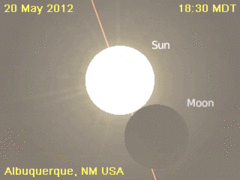

- Hong Kong
It was predicted that the antumbra would pass over Hong Kong but due to weather it was not observable.
Photo Gallery
Asia

 Aichi Prefecture, Japan
Aichi Prefecture, Japan- Kōfu, Japan
 Aoba-ku, Yokohama, Japan
Aoba-ku, Yokohama, Japan- 23 wards of Tokyo, Japan
 Tokyo, Japan
Tokyo, Japan.ogv.jpg) Video from Tokyo, Japan
Video from Tokyo, Japan Kashima, Ibaraki, Japan
Kashima, Ibaraki, Japan
USA
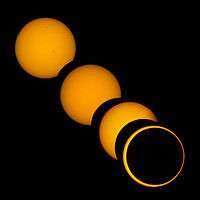
- Crescent shadows on an outdoor wall in San Francisco, California.
 Crescent shaped shadows from tree on a wall in San Francisco, California
Crescent shaped shadows from tree on a wall in San Francisco, California Crescent images from solar eclipse, May 2012 in San Francisco, California
Crescent images from solar eclipse, May 2012 in San Francisco, California Photo taken from San Francisco, California
Photo taken from San Francisco, California Composite image from Huntington Beach, California
Composite image from Huntington Beach, California From Palm Springs, California, wide angle
From Palm Springs, California, wide angle From Los Osos, California
From Los Osos, California Photo taken from San Juan Capistrano, California at 1:20 UTC
Photo taken from San Juan Capistrano, California at 1:20 UTC 80mm refractor, 1:36 UTC, Nevada City, California
80mm refractor, 1:36 UTC, Nevada City, California Near Phoenix, Arizona
Near Phoenix, Arizona Eclipse as seen from Flagstaff, Arizona
Eclipse as seen from Flagstaff, Arizona- Amateur scientists observing eclipse in Albuquerque, New Mexico.
 Center line, south shore of Pyramid Lake (Nevada) in Nevada.
Center line, south shore of Pyramid Lake (Nevada) in Nevada.- 2012-05-20 Eclipse as seen from Wolfforth, Texas.
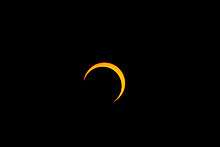 Partial Solar Eclipse in Salt Lake City, Utah.
Partial Solar Eclipse in Salt Lake City, Utah. From Pleasant Grove, Utah
From Pleasant Grove, Utah East of Ogden, Iowa at 1:25 UTC
East of Ogden, Iowa at 1:25 UTC Minneapolis, Minnesota at 1:27:53 UTC
Minneapolis, Minnesota at 1:27:53 UTC Projection method using 60mm refractor from Medford, Oregon.
Projection method using 60mm refractor from Medford, Oregon.
Related eclipses
Solar eclipses 2011–2014
Each member in a semester series of solar eclipses repeats approximately every 177 days and 4 hours (a semester) at alternating nodes of the Moon's orbit. Note: Partial solar eclipses on January 4, 2011, and July 1, 2011, occur in the previous semester series.
| Solar eclipse series sets from 2011–14 | ||||
|---|---|---|---|---|
| Descending node | Ascending node | |||
| Saros | Map | Saros | Map | |
| 118 | June 1, 2011 Partial |
123 | November 25, 2011 Partial | |
128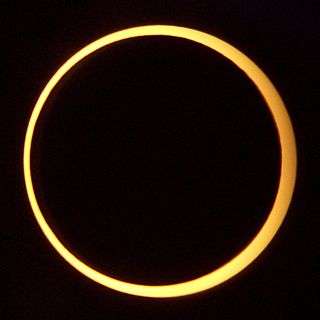 Middlegate, Nevada |
May 20, 2012 Annular |
133 Ellis Beach, Queensland |
November 13, 2012 Total | |
| 138 Churchills Head, Australia |
May 10, 2013 Annular |
143 Partial from Accra, Ghana |
November 3, 2013 Hybrid | |
| 148 | April 29, 2014 Annular |
153 Partial from Minneapolis |
October 23, 2014 Partial | |
Saros 128
It is a part of Saros cycle 128, repeating every 18 years, 11 days, containing 73 events. The series started with partial solar eclipse on August 29, 984 AD. It contains total eclipses from May 16, 1417 through June 18, 1471 and hybrid eclipses from June 28, 1489 through July 31, 1543. Then it progresses into annular eclipses from August 11, 1561 through July 25, 2120. The series ends at member 73 as a partial eclipse on November 1, 2282. The longest duration of totality was 1 minutes, 45 seconds on June 7, 1453.[1]
| Series members 52–62 occur between 1901 and 2100 | ||
|---|---|---|
| 52 | 53 | 54 |
 March 17, 1904 |
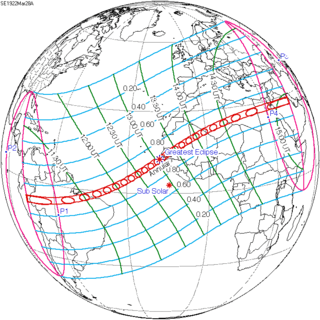 March 28, 1922 |
 April 7, 1940 |
| 55 | 56 | 57 |
 April 19, 1958 |
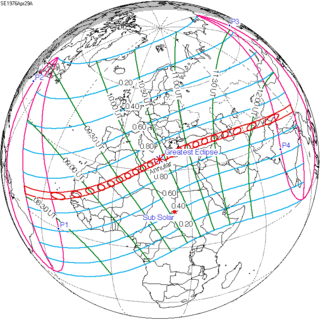 April 29, 1976 |
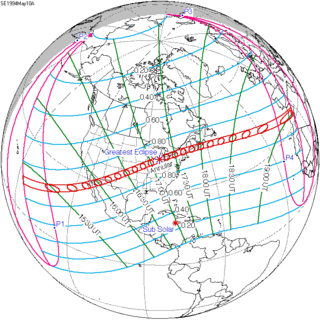 May 10, 1994 |
| 58 | 59 | 60 |
 May 20, 2012 |
 June 1, 2030 |
 June 11, 2048 |
| 61 | 62 | |
 June 22, 2066 |
 July 3, 2084 | |
Metonic series
| Octon series with 21 events between May 21, 1993 and August 2, 2065 | ||||
|---|---|---|---|---|
| May 20–21 | March 9 | December 25–26 | October 13–14 | August 1–2 |
| 118 | 120 | 122 | 124 | 126 |
 May 21, 1993 |
 March 9, 1997 |
 December 25, 2000 |
 October 14, 2004 |
 August 1, 2008 |
| 128 | 130 | 132 | 134 | 136 |
 May 20, 2012 |
 March 9, 2016 |
 December 26, 2019 |
 October 14, 2023 |
 August 2, 2027 |
| 138 | 140 | 142 | 144 | 146 |
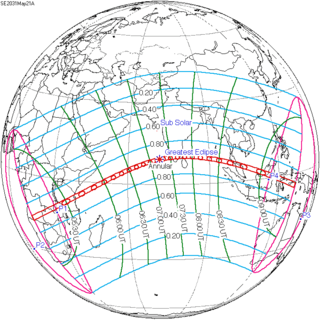 May 21, 2031 |
 March 9, 2035 |
 December 26, 2038 |
 October 14, 2042 |
 August 2, 2046 |
| 148 | 150 | 152 | 154 | 156 |
 May 20, 2050 |
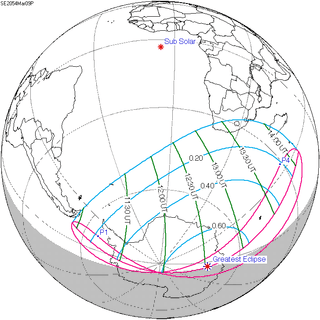 March 9, 2054 |
 December 26, 2057 |
 October 13, 2061 |
 August 2, 2065 |
| 158 | ||||
 May 20, 2069 | ||||
Notes
References
- Earth visibility chart and eclipse statistics Eclipse Predictions by Fred Espenak, NASA/GSFC
- Closeup map of path
- www.eclipser.ca: Jay Anderson 2012 May 20/21 Annular Solar Eclipse
- NightSkyInfo.com: May 20, 2012 Annular Solar Eclipse
- Photo Gallery from Big Spring TX
External links
| Wikimedia Commons has media related to Solar eclipse of 2012 May 20. |
- A Partial Solar Eclipse over Texas, APOD 5/22/2012, from 30 km west of Sundown, Texas, the same picture chosen as APOD again on 9/13/2015
- Looking Back at an Eclipsed Earth, APOD 5/30/2012, taken by MTSAT